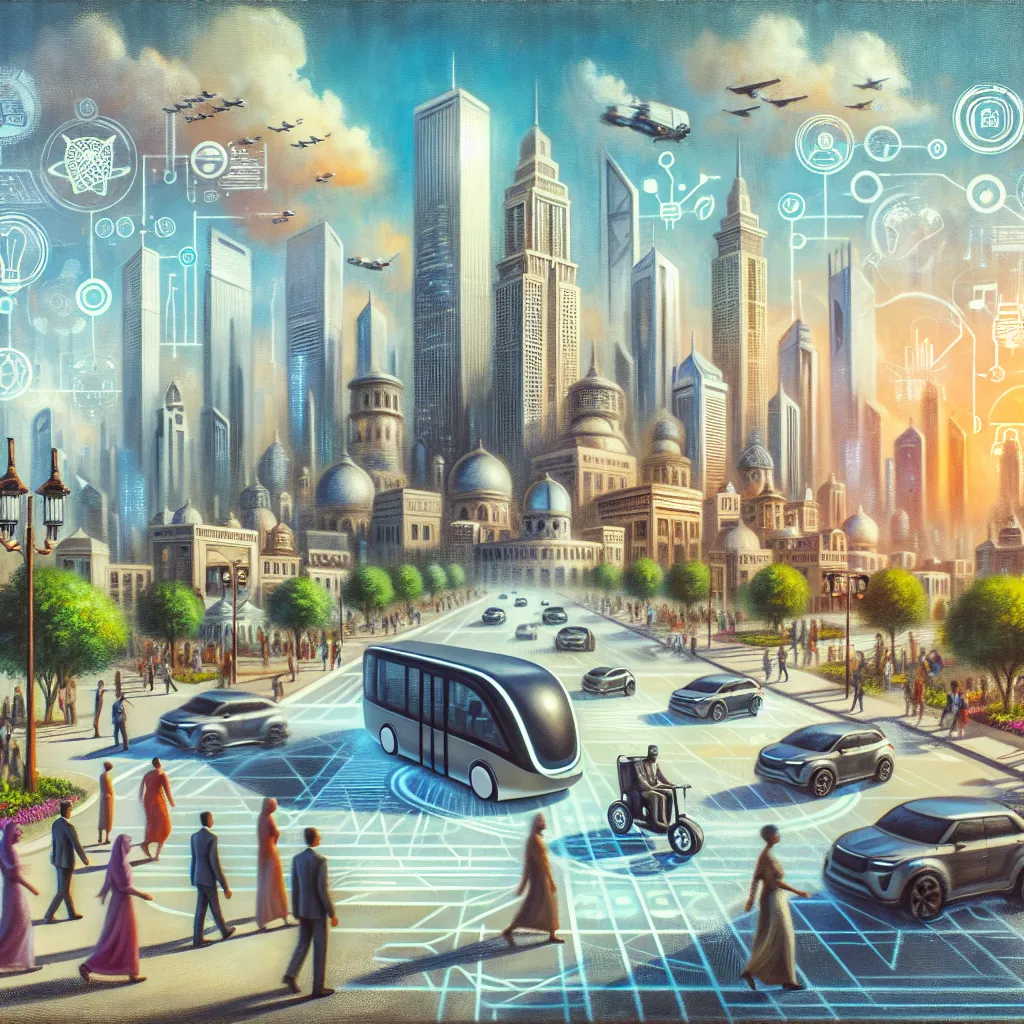Welcome to our IELTS Reading practice test focused on the future of autonomous vehicles and their potential impact on reducing traffic congestion. This comprehensive test will help you prepare for the IELTS Reading section by providing realistic passages and questions that mirror the actual exam format. Let’s dive into this fascinating topic and enhance your reading skills!
 Autonomous vehicles reducing traffic congestion
Autonomous vehicles reducing traffic congestion
Introduction
The IELTS Reading test is designed to assess your ability to understand and analyze complex texts. In this practice test, we’ll explore the exciting topic of autonomous vehicles and their potential to alleviate traffic congestion. This subject is not only relevant to the IELTS exam but also reflects current technological trends and urban planning challenges.
Reading Passage 1 (Easy Text)
The Promise of Self-Driving Cars
Self-driving cars, once a concept confined to science fiction, are rapidly becoming a reality. These autonomous vehicles (AVs) use sophisticated sensors, cameras, and artificial intelligence to navigate roads without human intervention. As cities worldwide grapple with increasing traffic congestion, many experts believe that AVs could offer a solution.
One of the primary advantages of autonomous vehicles is their potential to optimize traffic flow. Unlike human drivers, AVs can communicate with each other and with traffic management systems, allowing for more efficient use of road space. This seamless coordination could significantly reduce the stop-and-go traffic patterns that contribute to congestion.
Moreover, AVs are expected to reduce the number of accidents caused by human error, which often lead to traffic jams. By eliminating factors such as distracted driving, drunk driving, and aggressive behavior, autonomous vehicles could make roads safer and more efficient.
Another benefit of widespread AV adoption could be a reduction in the number of vehicles on the road. As ride-sharing services incorporate autonomous technology, more people might opt for shared rides instead of owning personal vehicles. This shift could lead to fewer cars occupying parking spaces and roads, further alleviating congestion.
However, the transition to a fully autonomous transportation system will not be without challenges. Infrastructure upgrades, changes in urban planning, and public acceptance are all hurdles that must be overcome. Despite these obstacles, many cities and companies are investing heavily in AV technology, recognizing its potential to revolutionize urban mobility and reduce traffic congestion.
Questions 1-5
Do the following statements agree with the information given in Reading Passage 1? Write
TRUE if the statement agrees with the information
FALSE if the statement contradicts the information
NOT GIVEN if there is no information on this
- Autonomous vehicles use only cameras to navigate roads.
- AVs can communicate with each other to optimize traffic flow.
- Human error is a significant cause of traffic accidents.
- All cities worldwide are currently using autonomous vehicles.
- The transition to autonomous vehicles will be challenge-free.
Questions 6-10
Complete the sentences below.
Choose NO MORE THAN TWO WORDS from the passage for each answer.
- Autonomous vehicles could reduce ____ ____ traffic patterns.
- AVs are expected to make roads ____ and more efficient.
- Widespread adoption of AVs might lead to a reduction in ____ ____.
- Many people might choose ____ ____ instead of owning personal vehicles.
- Cities and companies are investing in AV technology to revolutionize ____ ____.
Reading Passage 2 (Medium Text)
The Impact of Autonomous Vehicles on Urban Traffic
The integration of autonomous vehicles (AVs) into urban transportation systems has the potential to dramatically reshape how cities manage traffic congestion. While the full impact of this technology is yet to be realized, researchers and urban planners are exploring various scenarios and strategies to maximize the benefits of AVs in reducing traffic congestion.
One of the most promising aspects of AV technology is its ability to optimize road capacity. Traditional traffic systems are designed with human limitations in mind, requiring significant space between vehicles for safety. AVs, with their superior reaction times and ability to communicate with each other, can potentially operate much closer together, effectively increasing road capacity without physical expansion.
This increased efficiency could be particularly impactful in urban areas where space for new road infrastructure is limited. By allowing more vehicles to use existing roads safely, AVs could help alleviate congestion without the need for costly and disruptive road-widening projects.
Moreover, the integration of AVs with smart traffic management systems could lead to more dynamic and responsive traffic flow. These systems could use real-time data to route vehicles efficiently, avoiding congestion hotspots and distributing traffic more evenly across the road network. This level of coordination could significantly reduce travel times and improve the overall efficiency of urban transportation.
Another potential benefit of AVs in reducing congestion is their impact on parking. A significant portion of urban congestion is caused by vehicles circling for parking spaces. Autonomous vehicles could drop off passengers and then proceed to designated parking areas away from congested zones, or even continue to serve other passengers in a shared mobility model. This could free up valuable urban space currently devoted to parking, allowing for more efficient land use and potentially reducing the number of trips made into congested areas.
However, the relationship between AVs and congestion is not straightforward. Some experts warn of potential rebound effects, where the increased convenience of autonomous travel leads to more frequent and longer trips, potentially offsetting congestion benefits. Additionally, there are concerns about the transition period, where autonomous and human-driven vehicles share the road, potentially creating new challenges for traffic management.
To fully realize the congestion-reducing potential of AVs, cities will need to implement comprehensive strategies that integrate this technology with other transportation modes and urban planning initiatives. This might include redesigning streets to accommodate AVs more efficiently, developing new policies to encourage shared AV use, and investing in complementary public transportation systems.
As we move towards an autonomous future, it’s clear that while AVs offer significant potential for reducing urban traffic congestion, their success will depend on thoughtful implementation and integration with broader urban mobility strategies.
Questions 11-14
Choose the correct letter, A, B, C, or D.
-
According to the passage, autonomous vehicles could increase road capacity by:
A) Physically expanding roads
B) Operating closer together
C) Reducing the number of vehicles
D) Implementing new traffic laws -
The integration of AVs with smart traffic management systems could lead to:
A) More expensive road projects
B) Increased travel times
C) More even distribution of traffic
D) Higher fuel consumption -
How could autonomous vehicles impact parking in urban areas?
A) By creating more parking spaces
B) By increasing the demand for parking
C) By reducing the need for parking in congested areas
D) By eliminating all urban parking -
What is mentioned as a potential “rebound effect” of AV adoption?
A) Decreased road safety
B) Increased frequency and length of trips
C) Higher vehicle production costs
D) Reduced public transportation use
Questions 15-20
Complete the summary below.
Choose NO MORE THAN TWO WORDS from the passage for each answer.
Autonomous vehicles have the potential to significantly reduce urban traffic congestion through various mechanisms. They can optimize 15) ____ ____ by operating closer together, effectively increasing the number of vehicles that can use existing roads. Integration with 16) ____ ____ ____ systems could lead to more dynamic traffic flow, reducing travel times. AVs could also alleviate congestion caused by vehicles searching for 17) ____ ____, potentially freeing up urban space for other uses. However, experts warn of possible 18) ____ ____, where increased convenience might lead to more frequent travel. The transition period, where autonomous and 19) ____ ____ vehicles share the road, may create new challenges. To maximize the benefits of AVs, cities will need to implement comprehensive strategies that integrate this technology with other 20) ____ ____ and urban planning initiatives.
Reading Passage 3 (Hard Text)
The Socioeconomic Implications of Autonomous Vehicles in Traffic Congestion Reduction
The advent of autonomous vehicles (AVs) promises to revolutionize urban mobility and potentially alleviate the pervasive issue of traffic congestion. However, the integration of this technology into existing transportation ecosystems presents a complex interplay of technological, social, and economic factors that warrant careful consideration.
At the forefront of the potential benefits is the optimization of traffic flow through advanced AI-driven algorithms. These systems can theoretically coordinate vehicle movements with unprecedented precision, minimizing the inefficiencies that arise from human decision-making in traffic situations. By maintaining optimal speeds and distances between vehicles, AVs could significantly increase road capacity without the need for physical infrastructure expansion, a particularly valuable proposition in densely populated urban areas where space is at a premium.
Furthermore, the reduction in traffic accidents—a major cause of congestion—is another anticipated benefit of widespread AV adoption. Human error, which accounts for a vast majority of road accidents, could be substantially mitigated by the superior sensory capabilities and consistent decision-making of autonomous systems. This not only has the potential to save lives but also to reduce the economic burden associated with traffic-related incidents and the resultant congestion.
However, the relationship between AV adoption and traffic congestion is not unequivocally positive. Paradoxically, the increased efficiency and convenience of autonomous travel might lead to induced demand, a phenomenon where improved conditions stimulate additional usage. This could manifest in several ways: individuals might opt for longer commutes, leading to urban sprawl; the reduced ‘cost’ of travel time (as passengers can engage in other activities) might encourage more frequent trips; and the accessibility provided by AVs might enable mobility for previously underserved populations, thereby increasing overall vehicle miles traveled.
Moreover, the transition period, during which AVs and human-driven vehicles coexist on roads, presents unique challenges. The heterogeneity in driving behaviors could potentially exacerbate congestion in the short term, as the two systems adapt to each other. This phase will require carefully crafted policies and infrastructure adaptations to ensure smooth integration.
The economic implications of AV-driven congestion reduction are multifaceted. On one hand, decreased congestion could lead to significant economic benefits through reduced fuel consumption, increased productivity, and more efficient goods transportation. Conversely, certain sectors of the economy, such as traditional auto manufacturing and manual driving-related jobs, may face disruption, necessitating workforce transitions and potential economic restructuring.
From a social equity perspective, the impact of AVs on congestion and mobility access raises important questions. While AVs have the potential to provide increased mobility for those unable to drive, such as the elderly or disabled, there are concerns about the accessibility of this technology across different socioeconomic strata. The initial high costs of AVs might exacerbate transportation inequalities, with only affluent areas benefiting from reduced congestion in the early stages of adoption.
Urban planning and policy-making will play crucial roles in harnessing the congestion-reducing potential of AVs while mitigating potential negative externalities. This may involve reimagining urban spaces, with a shift away from car-centric design towards more holistic mobility ecosystems that integrate AVs with public transit, cycling, and pedestrian infrastructure. Policies encouraging shared AV use over private ownership could be instrumental in maximizing the technology’s benefits for congestion reduction.
In conclusion, while autonomous vehicles hold significant promise for alleviating urban traffic congestion, their impact is contingent upon thoughtful implementation that considers the broader socioeconomic context. As cities globally grapple with the challenges of urbanization and mobility, the integration of AVs into comprehensive, equitable transportation strategies will be paramount in realizing their full potential for creating more efficient, livable urban environments.
Questions 21-26
Complete the summary below.
Choose NO MORE THAN THREE WORDS from the passage for each answer.
Autonomous vehicles (AVs) have the potential to revolutionize urban mobility and reduce traffic congestion through 21) ____ ____ ____ that can coordinate vehicle movements with high precision. This could increase road capacity without the need for 22) ____ ____ ____. AVs are also expected to reduce traffic accidents caused by 23) ____ ____, which is a major source of congestion. However, the increased efficiency of AVs might lead to 24) ____ ____, potentially offsetting some congestion benefits. The transition period, where AVs and human-driven vehicles coexist, presents challenges due to 25) ____ ____ ____. The economic implications of AV adoption are complex, with potential benefits in reduced fuel consumption and increased productivity, but also possible disruptions in certain 26) ____ ____ ____.
Questions 27-33
Do the following statements agree with the claims of the writer in Reading Passage 3? Write
YES if the statement agrees with the claims of the writer
NO if the statement contradicts the claims of the writer
NOT GIVEN if it is impossible to say what the writer thinks about this
- Autonomous vehicles will completely eliminate the need for human drivers in the future.
- The increased efficiency of AVs might lead to more frequent and longer trips.
- The transition period between human-driven and autonomous vehicles will be smooth and without challenges.
- AVs have the potential to provide increased mobility for elderly and disabled individuals.
- The initial high costs of AVs might lead to inequalities in transportation access.
- Urban planning will need to shift away from car-centric design to fully benefit from AV technology.
- All cities globally have agreed on a unified approach to integrating AVs into their transportation systems.
Questions 34-40
Complete the sentences below.
Choose NO MORE THAN TWO WORDS from the passage for each answer.
- Advanced AI-driven algorithms in AVs can coordinate vehicle movements with unprecedented ____.
- The superior sensory capabilities of AVs could substantially mitigate accidents caused by ____ ____.
- The reduced ‘cost’ of travel time in AVs might encourage more ____ ____.
- The coexistence of AVs and human-driven vehicles during the transition period may ____ congestion in the short term.
- Decreased congestion due to AVs could lead to reduced ____ ____ and increased productivity.
- There are concerns about the ____ of AV technology across different socioeconomic groups.
- Policies encouraging ____ ____ ____ over private ownership could maximize the benefits of AVs for congestion reduction.
Answer Key
Reading Passage 1
- FALSE
- TRUE
- TRUE
- FALSE
- FALSE
- stop-and-go
- safer
- vehicle numbers
- shared rides
- urban mobility
Reading Passage 2
- B
- C
- C
- B
- road capacity
- smart traffic management
- parking spaces
- rebound effects
- human-driven
- transportation modes
Reading Passage 3
- AI-driven algorithms
- physical infrastructure expansion
- human error
- induced demand
- heterogeneity in driving
- economic sectors
- NOT GIVEN
- YES
- NO
- YES
- YES
- YES
- NOT GIVEN
- precision
- human error
- frequent trips
- exacerbate
- fuel consumption
- accessibility
- shared AV use
This IELTS Reading practice test provides a comprehensive examination of the future of autonomous vehicles in reducing traffic congestion. By working through these passages and questions, you’ll not only enhance your understanding of this important topic but also improve your reading skills for the IELTS exam.
Remember to practice regularly and familiarize yourself with various question types to perform well in the actual test. Good luck with your IELTS preparation!
For more IELTS practice materials and tips, check out our related articles on the rise of autonomous vehicles in public transportation and how public transportation can reduce urban congestion.


